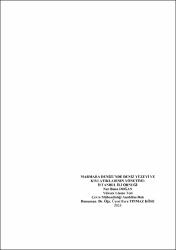| dc.contributor.author | Doğan, Nur Banu | |
| dc.date.accessioned | 2018-07-31T07:36:19Z | |
| dc.date.available | 2018-07-31T07:36:19Z | |
| dc.date.issued | 2018 | |
| dc.identifier.uri | https://hdl.handle.net/20.500.11776/2921 | |
| dc.description.abstract | Dünyanın yaşı ilerledikçe artan nüfus ve ihtiyaçlar, gelişen sanayi ve bunlara bağlı olarak ortaya çıkan çevresel sorunlar neticesinde dünyanın can damarları olan nehirler, denizler, okyanuslar, gün geçtikçe daha da kirlenmekte ve etkin, uygulanabilir, ekonomik, maksimum fayda sağlayan atık yönetimi kaçınılmaz hale gelmektedir. Denizlerdeki kirlilik deniz canlılarını, insanları ve dolayısı ile bütün ekosistemi olumsuz etkilemektedir. Bu temelde yapılması gereken, deniz kirliliğinin çeşitleri ve kaynaklarının doğru tespiti ile uygulanabilir çözümlerin ortaya konmasıdır. Bütün bunlar göz önünde bulundurulduğunda deniz yüzeyi ve kıyı atıklarının yönetimi de büyük önem taşımaktadır. Bu çalışmada İstanbul ili, deniz yüzeyindeki ve kıyıdaki atıkların toplanma yöntemleri ve bertarafına ilişkin aşamalar incelenmiştir. Daha etkin bir deniz yüzeyi ve kıyı atıkları yönetimine dayanak sağlaması amacıyla; 6 adet deniz yüzeyi ve 4 adet kıyı bölgesinden alınan atık numuneleri üzerinde, 2016 yılı boyunca, dört mevsimi temsil edecek şekilde, Nisan, Ağustos, Ekim ve Aralık aylarında karakterizasyon işlemi gerçekleştirilmiştir. İstanbul Büyükşehir Belediyesi Deniz Hizmetleri Müdürlüğü'nün görev kapsamında yer alan deniz ve çevresinin temizliği faaliyeti, İstanbul Çevre Yönetimi Sanayi ve Ticaret AŞ (İSTAÇ) tarafından gerçekleştirilmekte olup karakterizasyon çalışması için kıyı ekipleri ve 8 adet deniz yüzeyi temizleme teknesi ile toplanan atık numuneleri İSTAÇ Alibeyköy şantiyesine getirilmiş ve gruplandırma yapılarak tartım işlemi gerçekleştirilmiştir. Yapılan karakterizasyon çalışması sonucunda İstanbul ili deniz yüzeyi atıklarının içeriğinde; % 26,91 oranında geri dönüştürülebilir atık, %70,44 oranında biyobozunur atık ve %4,24 oranında diğer atıkların bulunduğu; kıyı şeridi atıklarının içeriğinde ise % 27,71 oranında geri dönüştürülebilir atık, %65,35 oranında biyobozunur atık ve %6,86 oranında diğer atıkların bulunduğu tespit edilmiştir. | en_US |
| dc.description.abstract | As the world grows older, the increase in human population and their needs, diminishing resources, developing industry and the environmental consequences resulting from them, the lifelines of the world, rivers, seas and oceans become increasingly polluted day by day, and the need for waste management which is effective, feasible, economical and maximally beneficial becomes inevitable. Pollution in the sea affects marine life, people and therefore the entire ecosystem. On this basis, it is necessary to establish the correct detection of the types and sources of marine pollution and the feasible solutions. Thus, the management of the sea surface wastes is of great importance. In this study, the methods of collecting and disposing of wastes on the sea surface and coast of city of Istanbul were examined. For the purpose of supporting a more efficient surface treatment of the sea surface; including the sea surface and coasts wastewater samples collected from the 6 sea surface 4 coastal regions, to represent four seasons throughout the year; characterization process was performed in April, August, October and December. The cleaning activites of the sea and its surroundings, which are included in the scope of the duty of the Directorate of Maritime Services of the Istanbul Metropolitan Municipality, are carried out by Istanbul Enviromental Management Industry and Trade Inc. (ISTAC). Waste samples collected by the coastal teams and 8 marine surface cleaning machines for the characterization work are collected and brought to Alibeyköy worksite and weighed by grouping. As a result of the characterization performed, it was determined that % 26,91 of waste collected from the surface in the Istanbul Bosporus area could be recyclable, %70,44 of waste was biodegradable and %4,24 was other wastes. % 27,71 of the waste collected from the shore in the Istanbul Bosporus area could be recyclable, %65,35 of waste was organic and %6,86 was other wastes. | en_US |
| dc.language.iso | tur | en_US |
| dc.publisher | Namık Kemal Üniversitesi | en_US |
| dc.rights | info:eu-repo/semantics/openAccess | en_US |
| dc.subject | Deniz Yüzeyi Atıkları | en_US |
| dc.subject | Kıyı Atıkları | en_US |
| dc.subject | Atık Karakterizasyonu | en_US |
| dc.subject | Sea Surface Runoff | en_US |
| dc.subject | Coastal Waste | en_US |
| dc.subject | Waste Characterization | en_US |
| dc.title | Marmara Deniz’inde deniz yüzeyi ve kıyı atıklarının yönetimi: İstanbul ili örneği | en_US |
| dc.title.alternative | SEA SURFACE AND COAST WASTE MANAGEMENT ON MARMARA SEA: THE EXAMPLE OF ISTANBUL PROVINCE | en_US |
| dc.type | masterThesis | en_US |
| dc.department | Enstitüler, Fen Bilimleri Enstitüsü, Çevre Mühendisliği Ana Bilim Dalı | en_US |
| dc.relation.publicationcategory | Tez | en_US |



















